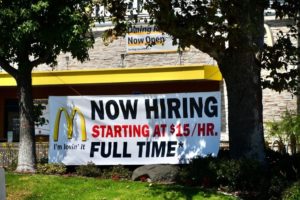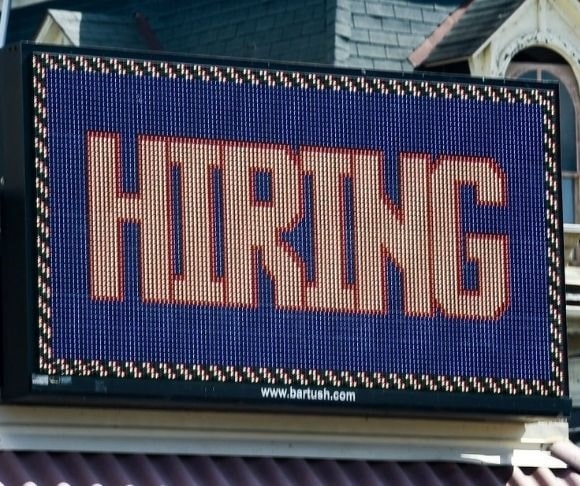The post-pandemic economy is seemingly looking nothing like the pre-coronavirus one. Despite the United States reopening, much to the chagrin of COVID cultists, the country is not roaring as many had anticipated. Inflation is red hot, store shelves are bare, employees are being terminated for choosing not to get the jab, and many Americans are still forced to wear masks and social distance. The cherry on top might be the September jobs report, something that economists expected was going to be, as former President Donald Trump would say, huge. Instead, the numbers were as disappointing as Citizen Kane not winning Best Picture at the Academy Awards.

A September to Dismember?
According to the Bureau of Labor Statistics (BLS), the U.S. labor market added 194,000 new jobs in September, the lowest reading in 2021. Financial analysts had anticipated 500,000 new positions. The unemployment rate fell to 4.8%, better than the median estimate of 5.1%. Average hourly earnings rose 0.6% to $30.85, average weekly hours edged up to 34.8, and the labor force participation rate dipped to 61.6%.
Unlike previous employment snapshots, the job creation was more diverse. Here is a look at the sectors where the employment opportunities were concentrated in the final month of the third quarter:
- Leisure and Hospitality: 74,000
- Professional and Business Services: 60,000
- Retail Trade: 56,100
- Transportation and Warehousing: 47,300
- Information: 32,000
- Manufacturing: 26,000
- Construction: 22,000
“Recent employment changes are challenging to interpret, as pandemic-related staffing fluctuations in public and private education have distorted the normal seasonal hiring and layoff patterns,” the BLS said in the news release

(Photo by Jeff Gritchen/MediaNews Group/Orange County Register via Getty Images)
One of the most notable developments in the latest data was government, particularly in public education, shedding 123,000 jobs. However, if state and local employment were erased from the monthly update, the private sector added more than 300,000 workers to payrolls, which would still be below economists’ forecasts.
The other critical component is that the size of the labor force contracted by 183,000, supporting the drop in the jobless rate. Ultimately, it comes down to employers encouraging more people to head back to the workplace with greater compensation packages and the government removing benefit crutches. Indeed, there is a demand for labor as job openings are at all-time highs of 11 million, but fewer applicants fill these jobs.
Nevertheless, the disappointing September report suggests the economic recovery is slowing, potentially giving pause to the Federal Reserve and its tapering plans sometime in the next couple of months. This was the chief concern among the Federal Open Market Committee (FOMC) before the Fed Board agreed to hit the brakes on the printing presses.
How the Market Reacted
 By the middle of the Oct. 8 trading session, the overall financial markets were relatively flat. The Dow Jones Industrial Average, S&P 500, and Nasdaq Composite Index traded sideways. Gold and silver prices were pretty much unchanged, while the U.S. Dollar Index (DXY) was hovering around the 94.00 mark. Treasury yields were up, with the benchmark 10-year bond adding 0.034% to 1.605%. Bitcoin rallied 1.05% to $54,620 and Ethereum picked up 0.8% to $3,637.
By the middle of the Oct. 8 trading session, the overall financial markets were relatively flat. The Dow Jones Industrial Average, S&P 500, and Nasdaq Composite Index traded sideways. Gold and silver prices were pretty much unchanged, while the U.S. Dollar Index (DXY) was hovering around the 94.00 mark. Treasury yields were up, with the benchmark 10-year bond adding 0.034% to 1.605%. Bitcoin rallied 1.05% to $54,620 and Ethereum picked up 0.8% to $3,637.
The Expert Class Gets It Wrong
In recent months, any time there had been a dreadful performance in the labor market, the consensus was that it would improve by September. Experts put forward a wide variety of reasons, particularly kids returning to school and parents having the time to find employment. This has yet to materialize, and employment levels are still short approximately six million from before the COVID-19 public health crisis. While it might be easy to dismiss the adverse outcomes of Bidenomics, there are still three years left to determine the efficacy of the president’s Build Back Better agenda. Based on early results and economic fundamentals, the likely conclusion is that Biden will mirror former President Barack Obama’s anemic economic record. That said, as author Oscar Wilde wrote in Lady Windermere’s Fan, “We are all in the gutter, but some of us are looking at the stars.”
~ Read more from Andrew Moran.




